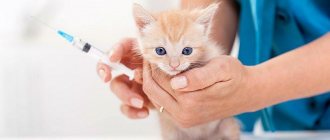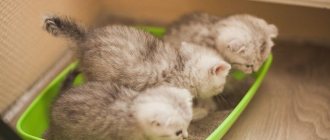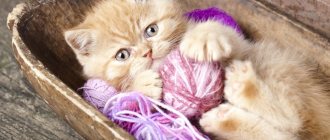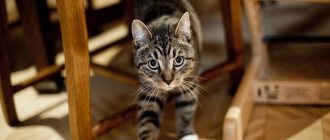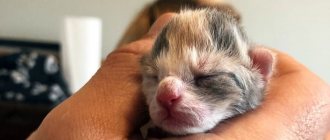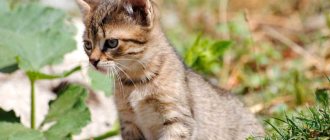Bengal cats are larger than normal cats
Due to the Bengal cat's shocking appearance, it is believed to grow to a large size. However, because the Bengal cat was bred from domestic cats to tame the wild side of its ancestor, it is comparatively similar in size to the average domestic cat.
And ultimately, that is what his breeders are trying to achieve; they want to create a cat that looks like it just ran out of the jungle and is calm enough to sit at home.
Advantages and disadvantages
- Pros:
- sociability, contact and almost dog-like devotion;
- love for other animals and children;
- Easy to care for – many Bengals love to swim, unlike other breeds.
- Minuses:
- high cost - even the cheapest pet-class kitten costs a decent amount;
- Bengal cats are also not the cheapest breed to keep - they need premium food and a lot of toys;
- Hyperactivity in Bengal cats can be a problem if there is no activity appropriate for it in the home.
How Big Can Bengal Cats Get?
A Bengal cat may grow larger than other domestic cats, but that doesn't mean they will. Although there are some huge Bengals, not all of them get that big.
Some Bengals weigh up to 9-10 kg. or more, like some other domestic cats. However, they are all muscular and are usually not classified as overweight (provided they follow a proper feeding regimen). In general, a male Bengal cat will be approximately 30% heavier than a female Bengal cat. Most Bengal cats weigh between 3 and 6 kg, with larger Bengal cats weighing on average 8 kg.
YouTube is full of videos of Bengal cats that have grown to the size of a five-year-old child. If you have Bengals, you may be nervous that they will reach an extremely unmanageable size, especially if you live in a smaller living space.
Additionally, the Great Bengal can be quite intimidating due to its energetic and unpredictable temperament.
Keep in mind that there is a chance that your Bengal will grow that big; however, they are unlikely to do so. Even if they do, they are tame enough that they will never pose a threat to you or your family.
What can I do to prevent my Bengal from gaining enough weight?
Of course, nature dictates that this breed of cat has healthy growth and heavy weight. However, if the animal is not cared for and cared for from birth, it will be difficult for it to meet the standards. Therefore, breeders or owners who give birth to Bengal kittens are required to adhere to certain rules.
These include:
- You should measure your kitten's weight every day to track how many grams he has gained. After two weeks of their life, this control can be reduced to once every three days;
- If small animals are not gaining weight well, then you should monitor the nutrition of the nursing mother. It must be of high quality and balanced. If the cubs still do not grow well, then the female should add more proteins and vitamins to the diet;
- If this point is also fulfilled, and the kitten is not gaining weight well, then you urgently need to show it to the veterinarian. If there is a need, he will prescribe the necessary treatment;
- When the kitten loses weight, you can gradually feed it with special baby food for kittens.
See also what food is suitable for Bengal cats.
This is all that concerns the first months of a kitten’s life. And if you have bought yourself a little Bengal who has already gained good weight, then you just need to provide him with high-quality and healthy nutrition, which will maintain not only his weight and appearance, but also his health.
And if you notice any changes in his behavior, appearance or well-being, then immediately contact an experienced specialist.
How tall is a Bengal cat?
Bengals are about the same size as their cat cousins; however, they have a significantly longer body. Similar in shape to the Asian leopard cat, the Bengal cat is designed to be fast, aerodynamic and maneuverable.
When you look at a Bengal cat from the outside, you will realize that although they have long hind legs, their torso has a stretched out appearance. A long body is characteristic of the Bengal breed.
The Bengal cat's long legs, long spine and back of the thighs are what make their torso so long. Tree-dwelling wild cats, such as the Asian leopard cat, have long bodies and legs to jump quickly from tree to tree.
Having reached maturity within the first two years of their lives, Bengal cats generally do not grow much longer after the age of two.
The growth of the Bengal
Although kittens can be born around 90 grams (maximum 120), after a week of their existence they already have a body weight of twice that. And after living its first month, the kitten weighs almost half a kilogram.
After this period, body weight gains a little slower. Having lived for 3 months, a Bengal cat should weigh a little more than one kilogram (see how much a kitten should weigh at 3 months).
The difference between males and females begins from a period of 7 months. It is in it that pets stop actively growing. However, females can gain a little more weight, while males are sure to gain significant kilograms by their first year of life.
This is where the difference between male and female will be visible. But experts say that cats gradually gain maximum kilograms even before they are two years old.
Naturally, for a kitten to be healthy and very handsome, its owners must help it with this.
What is the average weight of a Bengal cat?
Bengals, being slightly larger than ordinary domestic cats, can weigh. Females weigh 4-5 kg, and males - 6-9 kg.
Don't worry if your Bengal is lighter or heavier than these numbers. If your cat appears healthy, with little to no fat and plenty of muscle, her current weight will be where it should be.
You should carefully monitor your Bengal's weight. Being incredibly active creatures, they burn tons of calories. Your Bengal cat can be a 5 kg female and still be too thin. Healthy 6 kg. a domestic cat requires 270-320 calories per day; Since Bengals need more exercise than the average cat, you may need to increase your Bengal food intake.
Kitten 4 months old. Feeding, care, vaccinations and weight of a four-month kitten
Typically, 4-month-old kittens purchased from a nursery or from reputable breeders have received the necessary vaccinations and deworming.
Be sure to deworm your kitten. Now in veterinary pharmacies there is a huge selection of anthelmintic drugs from 30 to 350 rubles. The choice depends on your budget and how it would be more convenient for you to give your kitten an anthelmintic drug: in a tablet, paste or suspension.
After 10 days from the date of deworming, take the kitten to the veterinary clinic for vaccination. At 4 months old, a kitten can already be vaccinated against infectious diseases.
At 4 months, a kitten is practically a teenager and can feed itself perfectly well. Of course, it is better to consult with the breeder about nutrition and continue to feed what the kitten ate in the nursery. But if you don’t know what the baby ate, then you are faced with a dilemma about what to feed the kitten: ready-made dry food or natural food.
Feeding with ready-made dry food is simpler and more practical; pour the dry food into a bowl, pour in some fresh water and you can rest assured about the baby. The main thing here is not to skimp on food, not to feed the widely advertised Whiskas and Friskas. Remember, by saving on quality food you save on the kitten’s health. Buy premium or super premium food for your kitten, for example Royal Canin, Pro Plan, Bosch, Hills, Yams, Leonardo, Gina, etc. Eating good ready-made food is also good because dry food already contains the necessary vitamins and microminerals. Choose food according to the age of the kitten. A kitten at 4 months should be given food marked “for kittens”.
If you choose a natural type of food, then everything will be more complicated than when feeding “dry”. About there how to feed kittens at 4 months n
Source
Why is my bengal cat so small?
Although Bengal cats can grow larger than the average cat, they tend to be much slimmer. The Bengal's thin appearance makes them look thin; Many owners fear that they are not being fed enough. Bengal cats are also more muscular than other cats. This gives them incredible range of motion and agility.
Consult your local veterinarian to find out exactly how much you should feed your Bengals. Just keep in mind that a fat cat couldn’t be happier; In fact, it's the opposite. Cats that live truly fun lives are muscular and healthy. Fat that interferes with movement can frustrate and even depress your kitten, especially if he is as wild as a Bengal.
Don't take matters into your own hands if you think your Bengal cat is too small. Your veterinarian can help you develop a feeding regimen that best suits your cat's needs.
Cats that consume wet or dry food often gain more unwanted weight than cats that eat a purely raw diet (muscle tissue, secretory organs and bones). However, this is mainly due to the use of unwanted fillers.
Another thing to consider is that your cat may be late to show signs of symptoms. It is not uncommon for a Bengal cat to be stunted or reach its full size later. Although most Bengal cats stop growing by age 2, some may take up to 3 years to finally reach their size. This has to do with genetics, as well as things like feeding patterns, regular exercise, and other factors outside of your control.
Other factors that may affect your cat's growth rate include:
- Birth order
- Cat or cat
- Whether your cat has been neutered or not
- Diet
- The health of their biological mother
- Major health problems
Prohibited Products
It is important to exclude prohibited foods from your Bengal kitten’s diet:
- Bones, pure fat, skin, especially poultry.
- Palm oil.
- Grapes, raisins.
- Juicy and sweet fruits.
- Soy.
- Mushrooms.
- Corn and semolina.
- Raw freshwater fish.
- Dry, salted fish.
- Smoked products, including sausages, balyki, fish.
- Products containing sugar or its substitutes, xylitol (chewing gum, some sweets), flour or yeast, caffeine, cocoa, any stimulants (sweets, tea, coffee, chocolate), marinades, salt, spices.
- Dog food.
- Expired products.
- Leftovers from the table.
Controversial foods in the diet of a Bengal kitten are:
- Fresh pork is a source of helminths and false rabies.
- Raw ocean fish are a source of helminths.
- Whole milk – risk of individual intolerance.
- Chicken eggs are an allergen.
- Factory-bred chicken – risk of allergies and individual intolerances.
- Raw and boiled chicken liver in large quantities.
- Cereals.
Most veterinary nutritionists do not recommend including grains or additional sources of carbohydrates in a cat's diet.
The reason is that the cat’s body synthesizes enough carbohydrates to nourish the nervous system, and additional intake can lead to excess weight gain. However, if your pet is active and does not gain weight well, you can add buckwheat or rice to its diet.
How long do Bengal cats live?
Bengals, like other cats, live about 12–16 years, or longer if kept indoors. Some states mandate that Bengals be kept indoors only and microchipped; It is recommended to keep your Bengal cat inside at all times to avoid theft or premature death.
Outdoor cats, unfortunately, have a much shorter lifespan than indoor cats. While most indoor cats can live to be 18-20 years old, outdoor cats live on average 2-5 years.
This number is both devastating and shocking. Outdoor cats face endless dangers from both predators and humans, so keep your little ones safe and inside!
Outdoor cats are also more vulnerable to disease and injury. From jumping from trees to encountering wildlife, it is important to keep an eye on your cat when outdoors. Cats can safely roam outdoors as long as they are wearing a harness or under strict time restrictions. Cat sitting is a responsible task as a pet owner.
Why monitor the development of newborn kittens?
The weight of kittens is an indicator of their health.
Kittens can lose weight for the following reasons:
- congenital and acquired diseases;
- parasite infection;
- improper diet;
- breed or genetic abnormalities.
In order to timely identify deviations from the norm of nutrition and possible diseases, the owner of a Bengal cat is recommended to compare the kitten’s weight with the norms daily during the first weeks of life. In the future, the frequency of weighing can be reduced to 2 times a week.
Kitten weight from birth to one year
The weight of a cat depends primarily on the breed, lifestyle and nutrition. For example, the large Maine Coon breed: the weight of a kitten at birth is already greater than the average weight of a cat and is about 130-150 g; for comparison, the weight of a Scottish kitten is 80-120 g. In the Scottish breed, the weight of fold-eared cats and straight-eared cats does not differ.
The table shows the dynamics of the cat's weight by month: the weight of a Maine Coon kitten, the weight of a British kitten by month, the weight of a Scottish kitten by month.
The cat's weight by month shows a general trend of intensive growth in the first month, then the weight is gained a little more slowly, the cat's weight per year practically reaches its maximum, a stable normal weight of the cat is achieved at about 2.5 years. The cat's weight is shown in the table, first by week, then by month.
The kitten is not gaining weight. What to do?
If your kitten is not gaining weight, there may be several reasons. Firstly, there are many kittens in a litter, for example 5-6 or more, and then, perhaps, the baby simply does not have enough milk or a free nipple. Make sure he eats, put him close to his mother cat more often.
If there are really a lot of kittens, it is necessary to feed the kittens with concentrated fat milk from a pipette or pacifier.
It happens that kittens at 7-9 months stop gaining weight or even lose it altogether. This is most likely due to the fact that at this time they go through puberty and hormonal changes.
An adult cat does not gain weight for the same reason. If your cat's heat is long and frequent, be sure to give her sedatives, but under no circumstances breed animals before one year of age. Early matings have serious consequences. See the table for the normal weight of a cat.
We will also consider and compare the weight of cats of different popular sizes.
Source



